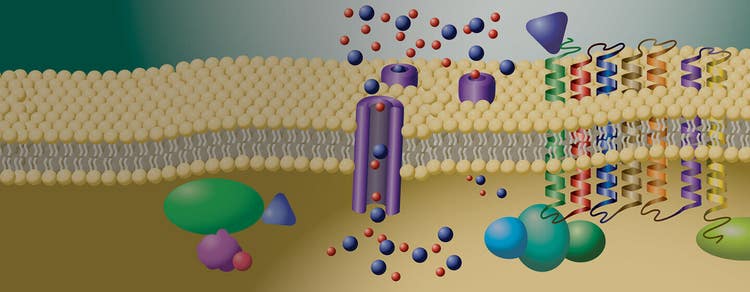GPCRs (G protein-coupled receptors)
GPCRs or G protein-coupled receptors are proteins located on the cell surface that recognize extracellular substances and transmit signals across the cell membrane. GPCRs do this by activating guanine nucleotide-binding proteins (G protein) that are responsible for signal transduction inside the cell. The signal delivery is very important in various cellular responses including cell growth, gene transcription, post-translational changes, and communication with other cells. This brings on adjustments in the body to adapt to the environmental changes such as increased heart rate when feeling threatened or change in vision in response to dim light.
The human genome alone consists of at least 1,000 different GPCRs that detect hormones, lipids, amines, neurotransmitters, and light, among other things.
A GPCR consists of three regions. The extracellular part detects and binds the ligand. Then, the seven-transmembrane region undergoes a conformational change. Finally, this change activates the C-terminus that triggers the corresponding G-protein.

iPS cell-derived cardiomyocytes are especially attractive cell models because they represent gene expression profiles as well as phenotypic characteristics similar to native cardiac cells.
G protein-coupled receptors and ion channels
GPCRs are the largest protein family, with between 600 and 1000 members, and have been linked to many normal biological as well as pathological conditions. They are also known as seven transmembrane (7-TM) receptors, and about 45% of modern medicinal drugs affect this target class. The function of GPCRs is highly diverse, recognizing a wide range of ligands, including photons, small molecules, and proteins.
Ion channels are pores in the cellular membrane that allow ions to pass in and out of the cell. There are over 400 genes for ion channels in the human genome. Many of them have been targeted by drugs that are now blockbusters. Direct measurement of ion channel activity is measured using traditional electrophysiology equipment for patch-clamping. However, the throughput is very low. Ion channel activity can also be measured indirectly with much higher throughput by using fluophores sensitive to changes in membrane potential, calcium flux, and potassium flux.
Monitor GPCR activity for drug discovery
Changes in GPCR activity lead to abnormalities in cellular signaling pathways, which result in inflammation, cardiovascular diseases, mental disorders, hormonal imbalances, and cancer. That’s why GPCRs are at the center of drug discovery, with approximately 34% of all FDA-approved drugs targeting 108 well-defined GPCRs.
Various assays can be used in drug discovery to monitor GPCR activity and corresponding intracellular changes.
Calcium is an important messenger triggered by GPCR activity. Therefore, changes in intracellular calcium signaling are strong indicators of the activation state of GPCRs. Calcium flux assays can be used to monitor intracellular calcium levels in drug screening.
Monitoring calcium oscillations is also crucial to predicting in vitro toxicity of your drug candidates.
Cyclic Adenosine Monophosphate (cAMP) is another important messenger involved in signal transduction pathways. The change in intracellular cAMP levels indicates the specific GPCR-G Protein coupling. cAMP assays can give valuable information about the GPCR subtypes.
It is also possible to monitor the GPCR activity through transfluor assays, where the main focus is on GPCR desensitization upon ligand binding. These assays can be implemented in drug screening to monitor GPCR activation/deactivation and movement across the cell membrane.
Solutions for identifying early leads against GPCRs
We offer a variety of assay and instrument solutions to support studies of GPCR and ion channel function including assay kits, cellular screening and imaging systems, and microplate readers.
Here we focus on applications using the FLIPR High-Throughput Cellular Screening System, the Screenworks Peak Pro 2 software module along with various FLIPR assay kits to provide a high-throughput kinetic screening solution for toxicology and lead compound identification.
